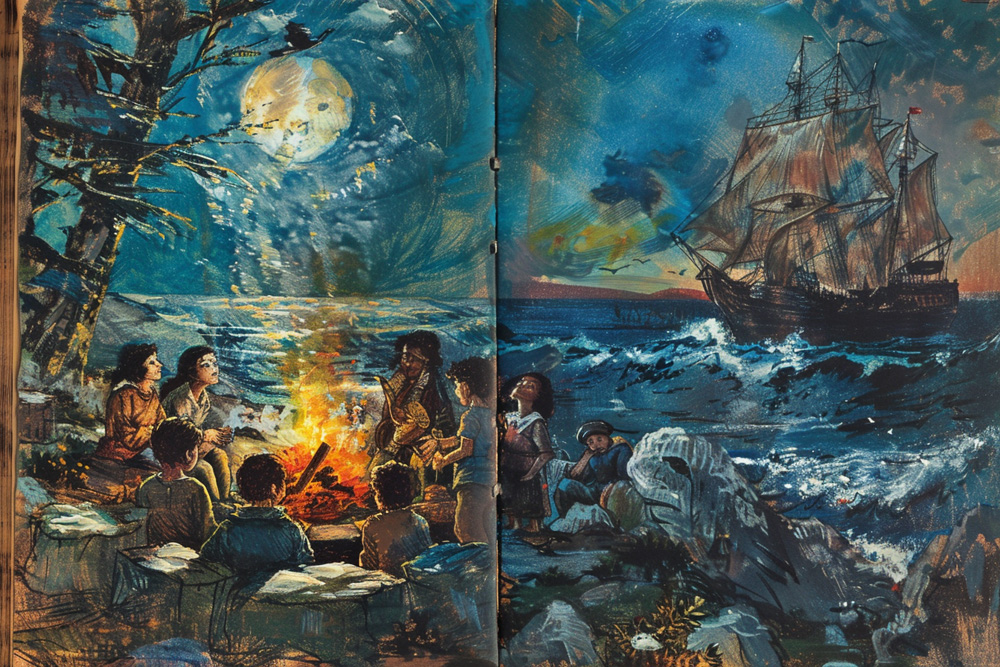KidZone Maritime History
"The Wellerman" Lyrics and Explanations
Verse 1:
There once was a ship that put to sea,
And the name of that ship was the Billy o' Tea.
The winds blew hard, her bow dipped down,
Blow, me bully boys, blow."
Explanation: This verse introduces the ship "Billy o' Tea" as it embarks on its journey. The mention of the winds blowing hard and the bow dipping down describes the rough sea conditions the sailors faced. This sets the stage for the sailors' tough yet spirited attitude towards the unpredictable sea conditions. Imagine the crew bracing themselves as the ship's bow dips into the waves—typical day at sea!
Chorus:
Soon may the Wellerman come
To bring us sugar and tea and rum.
One day, when the tonguin' is done,
We'll take our leave and go.
Explanation: The chorus expresses the crew's hopeful anticipation for the Wellerman's arrival with much-needed supplies. "Tonguin'" refers to the process of cutting strips of blubber from whales, a messy, smelly job that makes you appreciate those supplies even more. The supplies brought by the Wellerman, such as sugar, tea, and rum, were essential for maintaining the crew's morale and health during long voyages.
Verse 2:
She had not been two weeks from shore
When down on her a right whale bore.
The captain called all hands and swore
He'd take that whale in tow."
Explanation: Two weeks into the voyage, they encounter a right whale, which is a species of large baleen whale known for its valuable blubber and oil. The captain's call to "all hands" (the entire crew) to take the whale in tow illustrates the collective effort required for whaling. Towing involves attaching lines to the whale to bring it alongside the ship, enabling the crew to process the whale. This verse shows the physical and coordinated work involved in capturing a whale, an important and hazardous part of their job.
Verse 3:
Before the boat had hit the water
The whale's tail came up and caught her.
All hands to the side, harpooned and fought her
When she dived down below.
Explanation: This verse depicts the dangerous moment when the crew attempts to launch a boat to catch the whale. The whale's tail hitting the boat highlights the immense power and danger involved in whaling. The crew's response, using harpoons and struggling with the whale, shows the intense effort and skill required in whaling operations. Harpoons were used to secure the whale, and the crew had to work together to manage the struggle and prevent the whale from escaping.
Verse 4:
No line was cut, no whale was freed;
The captain's mind was not of greed,
And he belonged to the Whaleman's creed;
She took that ship in tow.
Explanation: This verse emphasizes the persistence and determination of the crew. "No line was cut, no whale was freed" indicates that they maintained their grip on the whale despite the struggle. The captain's adherence to the "Whaleman's creed" suggests a code of conduct among whalers, focused on the successful capture of the whale. This highlights the discipline and dedication within the whaling community, where the crew's collective effort and adherence to their code were paramount. Towing the whale involved securing it to the ship and ensuring it didn't escape, requiring careful coordination and strength.
Verse 5:
For forty days or even more,
The line went slack, then tight once more;
All boats were lost, there were only four,
But still that whale did go.
Explanation: This verse depicts the prolonged and exhausting nature of the whale hunt. The "forty days or even more" indicates the extended duration of the struggle, with the whale periodically causing the line to go slack and then tight again. The loss of all boats except four highlights the significant challenges and setbacks faced by the crew. Despite these difficulties, the whale continues to evade capture, showcasing the relentless determination of both the whale and the sailors. This underscores the high stakes and unpredictable outcomes of whaling, as well as the resilience required to endure such long and arduous endeavors.
Verse 6:
As far as I've heard, the fight's still on;
The line's not cut, and the whale's not gone.
The Wellerman makes his regular call
To encourage the captain, crew, and all.
Explanation: This verse suggests that the struggle with the whale is ongoing, symbolizing the never-ending challenges faced by sailors. "The Wellerman makes his regular call" indicates that the supply ship continues to visit, providing much-needed support and encouragement to the crew. This highlights the critical role of supply ships in maintaining the morale and sustenance of the sailors, ensuring they have the resources to continue their work. The ongoing fight with the whale reflects the enduring nature of maritime challenges and the reliance on periodic support to keep the crew motivated and equipped.
Chorus:
Soon may the Wellerman come
To bring us sugar and tea and rum.
One day, when the tonguin' is done,
We'll take our leave and go.
Explanation: The final repetition of the chorus encapsulates the sailors' enduring hope for the arrival of the Wellerman and the completion of their arduous tasks. This ongoing anticipation reflects the repetitive and cyclical nature of maritime life, where the arrival of supply ships and the completion of labor-intensive work were recurring themes. The chorus captures the blend of hard work, reliance on external support, and the moments of relief that characterized the lives of sailors and whalers. It’s a bit like the sailors’ version of “Work hard, play hard”—with the Wellerman’s supplies being their reward for enduring the tough life at sea.
